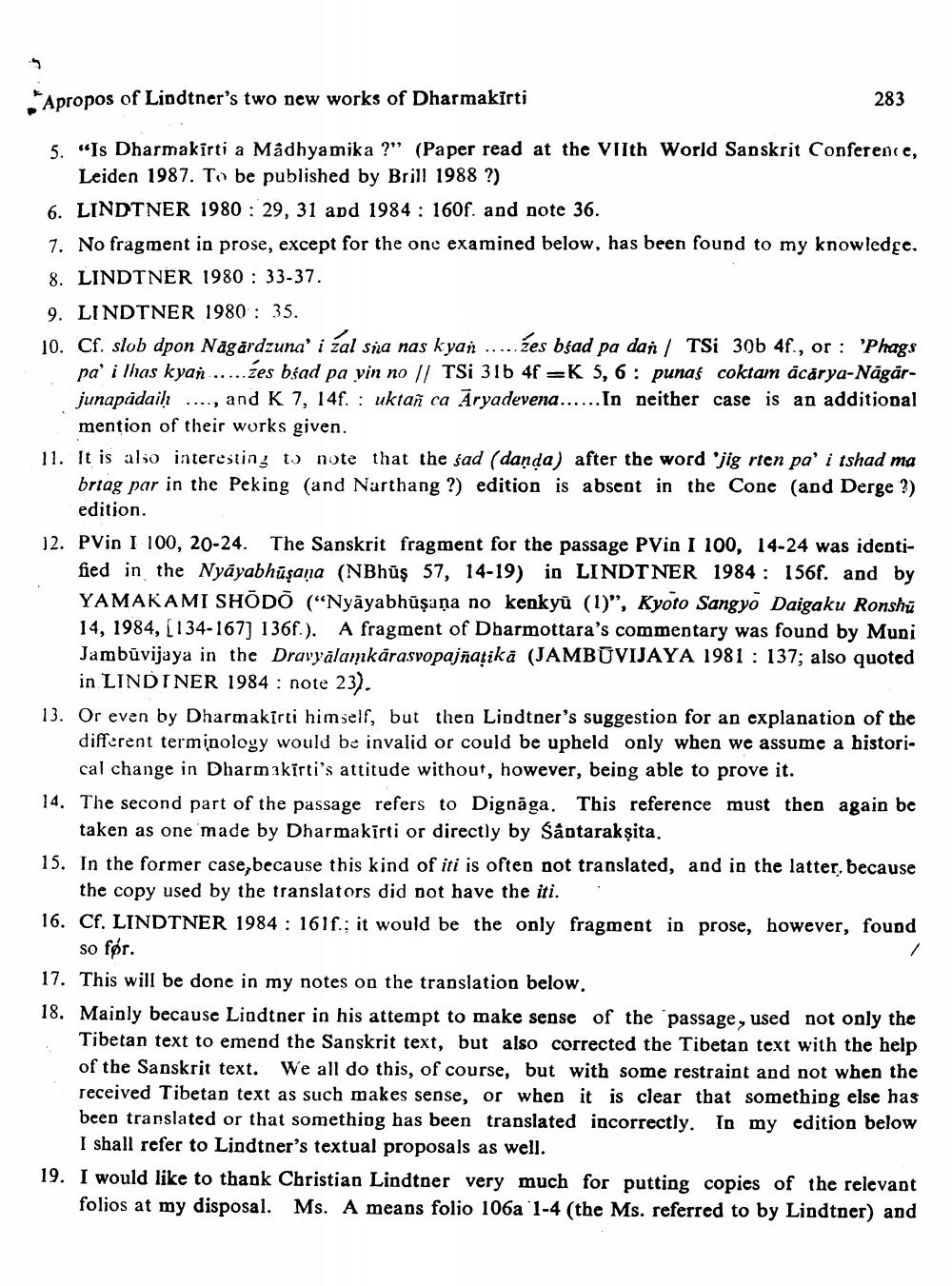________________
Apropos of Lindtner's two new works of Dharmakirti
283
5. “Is Dharmakirti a Madhyamika ?" (Paper read at the VIIth World Sanskrit Conference,
Leiden 1987. To be published by Brill 1988 ?) 6. LINDTNER 1980 : 29, 31 and 1984 : 160f. and note 36. 7. No fragment in prose, except for the one examined below, has been found to my knowledge. 8. LINDTNER 1980 : 33-37. 9. LINDTNER 1980 : 35. 10. Cf. slob dpon Nagärdzuna' i zal sia nas kyan .....zes bsad pa dan / TSI 306 4f., or: 'Phags
pa' i lhas kyan ......zes bśad pa yin no // TSI 316 4f =K 5, 6: punas coktam ācārya-Nägarjunapádaih ...., and K 7, 14. : uktañ ca Aryadevena...... In neither case is an additional
mention of their works given. 11. It is also interesting to note that the sad (danda) after the word 'jig rten pa' i tshad ma
briag par in the Peking (and Narthang ?) edition is absent in the Cone (and Derge ?)
edition. 12. PVin I 100, 20-24. The Sanskrit fragment for the passage PVin I 100, 14-24 was identi
fied in the Nyāyabhūşana (NBhūş 57, 14-19) in LINDTNER 1984 : 156f. and by YAMAKAMI SHODO ("Nyāyabhūşaņa no kenkyū (1)", Kyoto Sangyo Daigaku Ronshū 14, 1984, [134-167) 136f.). A fragment of Dharmottara's commentary was found by Muni Jambūvijaya in the Dravyalamkarasvopajñatika (JAMBUVIJAYA 1981 : 137; also quoted
in LINDINER 1984 : note 23). 13. Or even by Dharmakirti himself, but then Lindtner's suggestion for an explanation of the
different terminology would be invalid or could be upheld only when we assume a histori
cal change in Dharm akirti's attitude without, however, being able to prove it. 14. The second part of the passage refers to Dignāga. This reference must then again be
taken as one made by Dharmakirti or directly by Saptarakṣita. 15. In the former case, because this kind of iti is often not translated, and in the latter, because
the copy used by the translators did not have the iti. 16. Cf. LINDTNER 1984 : 1611.; it would be the only fragment in prose, however, found
so før. 17. This will be done in my notes on the translation below, 18. Mainly because Lindtner in his attempt to make sense of the passage, used not only the
Tibetan text to emend the Sanskrit text, but also corrected the Tibetan text with the help of the Sanskrit text. We all do this, of course, but with some restraint and not when the received Tibetan text as such makes sense, or when it is clear that something else has been translated or that something has been translated incorrectly. In my edition below
I shall refer to Lindtner's textual proposals as well. 19. I would like to thank Christian Lindtner very much for putting copies of the relevant
folios at my disposal. Ms. A means folio 106a 1-4 (the Ms. referred to by Lindtner) and




